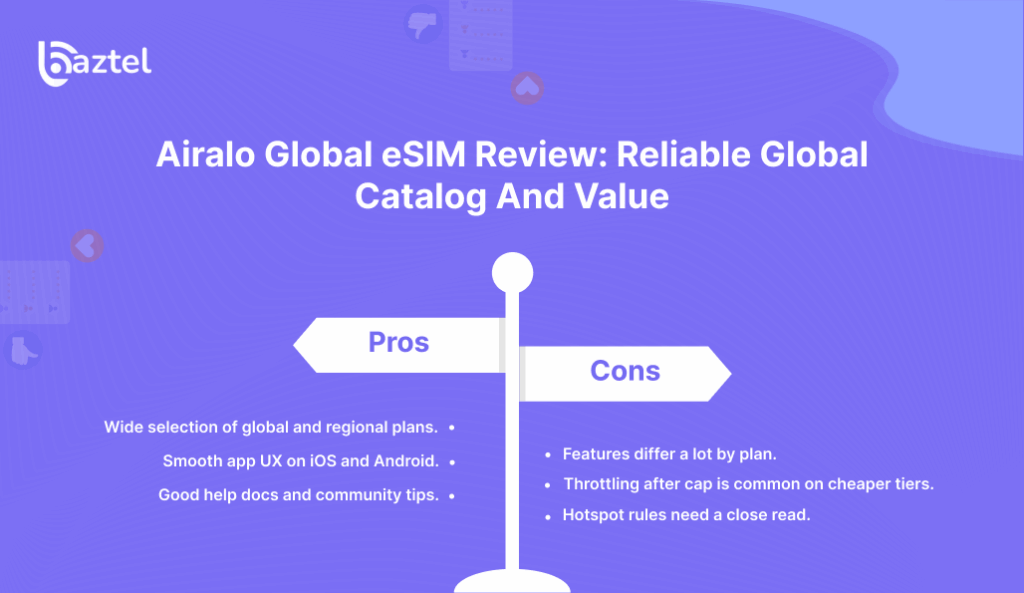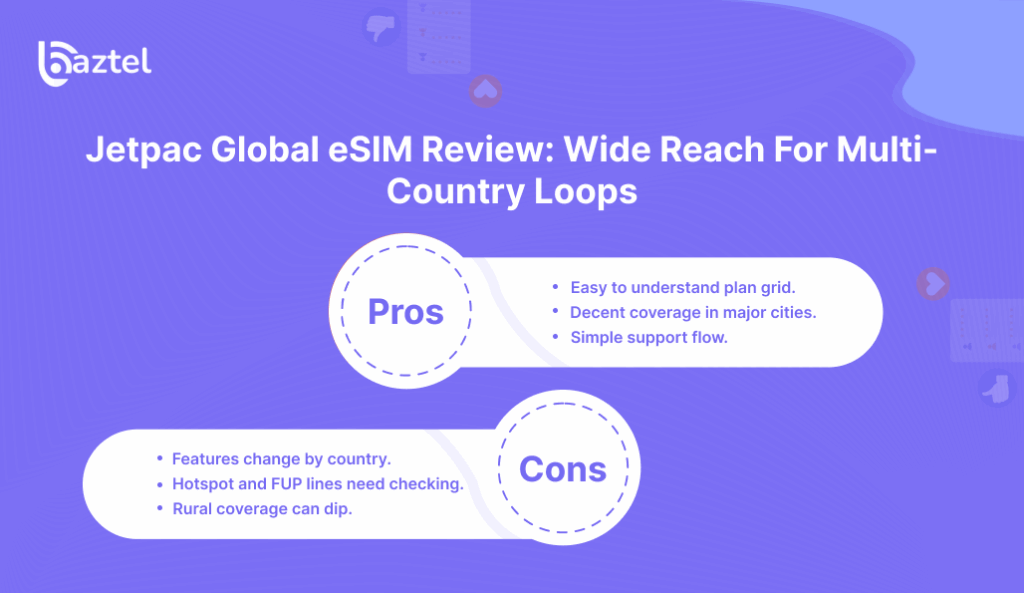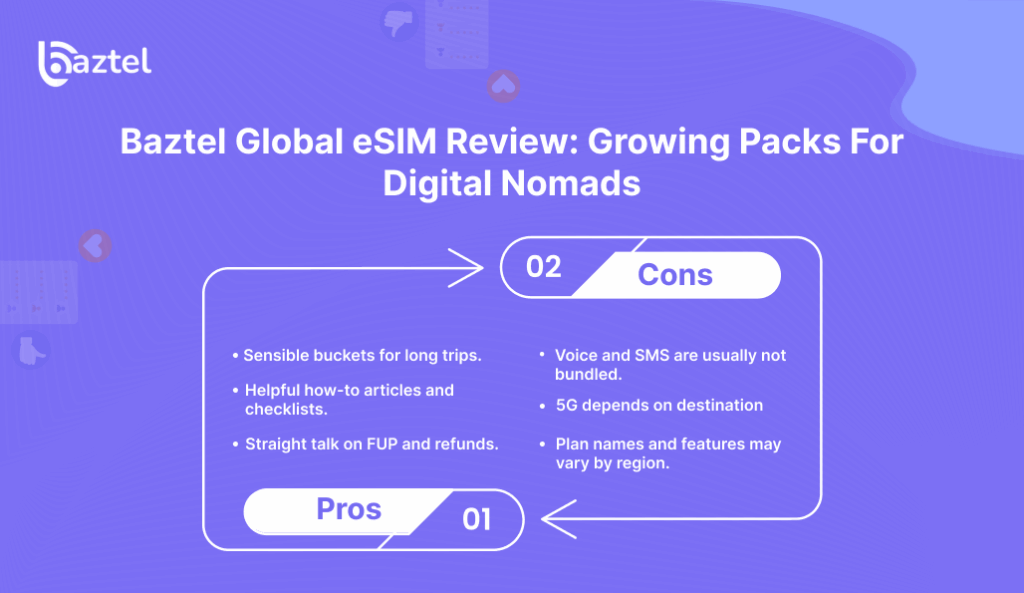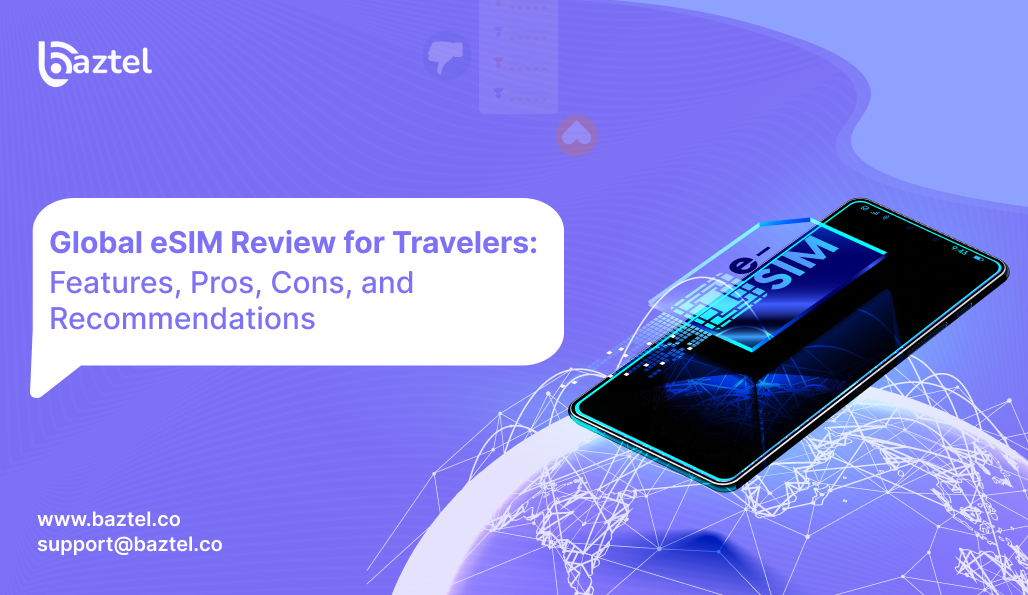Travel is back, data needs are bigger, and eSIMs are now mainstream. GSMA projects that about 35% of smartphone connections will use eSIM in 2025. That means easier setup, faster switching, and more choice for travellers.
The money tells the same story. One industry study values the global eSIM market at $1.46B in 2024, with growth expected to $6.29B by 2032. This is not a fad. It is a steady shift in how phones connect.
Devices are pushing this change too. All iPhone 14 and later models sold in the United States are eSIM-only, which nudged many first-time users to try digital activation. Android makers and carriers now publish clear eSIM guides and support lists as well.
In this global eSIM review, we keep it simple and useful. You will see how global eSIMs work, how to set them up on iPhone and Android, which providers stand out, what to watch for with fair-use rules, and quick picks by trip type.
What Are Prepaid Global eSIMs & Why Use Them?
Prepaid global eSIMs make travel internet simple. You buy a plan online, scan a QR code, and the data profile sits inside your phone. No plastic card. No shop visit. One plan can cover many countries, so you do not keep swapping SIMs. You pay upfront, so there are no surprise bills. You can still keep your home SIM active for OTPs and bank alerts. If a network gets weak, many global plans let your phone switch to a partner in the same country. That means smoother maps, rides, and calls over data. For a deeper dive on benefits, see Benefits of eSIM for travelers.
What is a global eSIM?
A global eSIM is a prepaid mobile data profile that you download to your phone. It works across many countries using partner networks. You buy it from an app or website, then install it by scanning a QR code or entering an activation code. After install, you get a new data line on your phone. You can keep your physical SIM for calls and OTPs. You can also set the eSIM as the default for mobile data. For most trips, this gives you the internet for maps, cabs, messages, and video.
How does global eSIM work?
Here is the simple flow if you are asking how does eSIM work for international travel or how does an eSIM work internationally. You pick a global plan by days or by data size. You pay once. You receive a QR code. Your phone downloads the profile and the access settings. When you land, you turn on the eSIM line and data roaming. The phone connects to a listed partner network in that country. If the provider supports multi-network access, the device can switch to another partner when the signal drops. Speeds depend on the local network, 4G or 5G support, and any fair-use rules in your plan.
Who are they for?
Global eSIMs fit short city breaks, long multi-country trips, and remote work. They help frequent flyers who cross borders often. They help families who want one clear plan per person. They also work for creators and business travelers who need a backup data line. If you plan weeks across regions, scan these two guides next for planning depth and sample plan paths: Global eSIM plans for international travel.
Head-to-Head: Global eSIM Comparison Table
Use this quick scan to shortlist providers. Counts and features change by plan and country, so treat these as guidelines and always check the plan page before you pay.
| Provider | Coverage (stated) | 5G | Hotspot/tethering | Voice/SMS |
| Saily | The global plan covers 113 destinations. | Select markets. | Varies by plan, check plan page. | Data-only. |
| Airalo (Discover/Discover+) | 138+ destinations for Discover(+). | Select markets. | Varies by plan, check notes. | Discover+ includes calls, texts, US number. |
| Nomad | 200+ destinations. | 4G/5G in many cities. | Varies by plan. | Data-only. |
| Jetpac | 200+ destinations. | Select markets. | Varies by plan. | Data-only. |
| aloSIM | Global plan in 150 countries. | Select markets. | Varies by plan. | Data-only. |
| Instabridge | 116 countries supported it. | Select markets. | Varies by plan. | Data-only. |
| Baztel | Global and regional packs, coverage varies by plan. | Select markets. | Varies by plan. | Data-only. |
Need a deeper face-off? Read this provider duel next: Airalo vs Holafly (comparison).
The Top Prepaid Global eSIM Providers: In-Depth Reviews
Use these mini reviews to shortlist two or three options. Details change by plan and country. Always check the plan page before you pay.
Saily Global eSIM Review: Best Overall Pick For 2025
Why it stands out. Clean app, clear plans, privacy-first brand roots. Good balance of coverage, speeds, and support.
Best for. Frequent travelers who want a simple app and stable service.
Pros
- Simple setup and quick activation.
- Clear plan names and upfront caps.
- Solid city coverage in popular routes.
Cons
- Voice and SMS are usually not included.
- Hotspot rules vary by plan.
- Rural reach depends on partner networks.
Setup notes. Install before you fly. Keep home SIM for OTPs. Turn on data roaming on arrival.
Airalo Global eSIM Review: Reliable Global Catalog And Value

Why it stands out. Huge catalog, global bundles, and regional packs. Discover+ adds calling and texts in select markets.
Best for. Value hunters, beginners, and anyone who loves choice.
Pros
- Wide selection of global and regional plans.
- Smooth app UX on iOS and Android.
- Good help docs and community tips.
Cons
- Features differ a lot by plan.
- Throttling after cap is common on cheaper tiers.
- Hotspot rules need a close read.
Setup notes. Scan QR, set as data line, test with Maps. Check FUP lines before buying.
Nomad Global eSIM Review: Flexible Option For Frequent Flyers
Why it stands out. Transparent pricing, easy top-ups, and solid country coverage.
Best for. Travelers who do 3 to 6 trips a year and want quick add-ons.
Pros
- Clear price per GB on most plans.
- Handy top-up flow during trips.
- Good app stability.
Cons
- Some plans are data-only.
- 5G is not everywhere yet.
- Speeds vary in peak hours.
Setup notes. Preload the app. Add a small top-up as a buffer for work calls.
Jetpac Global eSIM Review: Wide Reach For Multi-Country Loops

Why it stands out. Broad destination list and straightforward bundles.
Best for. Long routes across regions and one-month workcations.
Pros
- Easy to understand plan grid.
- Decent coverage in major cities.
- Simple support flow.
Cons
- Features change by country.
- Hotspot and FUP lines need checking.
- Rural coverage can dip.
Setup notes. Download offline maps for border days. Expect speed swings at rush hours.
aloSIM Global eSIM Review: Beginner-Friendly And Easy To Use
Why it stands out. Clean install steps and plain language around plans.
Best for. First-time eSIM users who want a gentle start.
Pros
- Clear how-to screens during setup.
- Helpful country lists and notes.
- Good for short trips.
Cons
- Some plans are 4G only.
- Price per GB can vary by region.
- Limited voice options.
Setup notes. Keep Wi-Fi on while installing. Label the line clearly in settings.
Instabridge Global eSIM Review: Added Security And Tools
Why it stands out. App ecosystem with security-minded features and connectivity tools.
Best for. Travelers who like extra privacy features and simple controls.
Pros
- Useful in-app network tools.
- Straightforward activation path.
- Clear data balance views.
Cons
- Not all countries have 5G.
- Voice add-ons limited.
- Hotspot rules vary.
Setup notes. Test a quick call over data before meetings. Keep updates off on mobile data.
Baztel Global eSIM Review: Growing Packs For Digital Nomads

Why it stands out. Practical plan mixes and a focus on long-stay travelers. Clear help guides across many countries.
Best for. Remote workers and creators who want predictable data for a month or more.
Pros
- Sensible buckets for long trips.
- Helpful how-to articles and checklists.
- Straight talk on FUP and refunds.
Cons
- Voice and SMS are usually not bundled.
- 5G depends on destination
- Plan names and features may vary by region.
Setup notes. Install before airport day. Keep home number active for OTPs and banking.
How to choose fast. Pick two providers that cover all your stops. Compare price per GB using only the high-speed cap. Check hotspot and FUP lines. If both look good, buy the plan with better support hours in your time zone.
Alternatives & Comparisons
Use this quick guide to see when a global eSIM wins, and when a different option fits better.
eSIM vs International Roaming
Roaming is simple, but it is costly and hard to track. You pay day passes or per-MB rates. A global eSIM is prepaid. You know your cap. You can add more only when you need it. For short trips, roaming can work if your carrier has a rare promo. For most multi-country routes, prepaid eSIMs give better control in this global eSIM review.
Choose eSIM when: you want a clear cap, hotspot, and easy top-ups.
Choose roaming when: your carrier gives a one-off deal and you only need light data.
eSIM vs Pocket Wi-Fi
Pocket Wi-Fi shares one connection with your devices. It works well for groups that stay together all day. It needs charging, pickup or delivery, and a deposit in some places. eSIM runs on your phone, no device to carry.
- Read the head-to-head guide: eSIM vs pocket Wi-Fi.
- Learn the tech basics first: How does portable Wi-Fi work.
Choose eSIM when: you travel solo, move fast, or want fewer gadgets.
Choose Pocket Wi-Fi when: a family wants one shared plan and you can manage charging.
Physical SIM vs eSIM
Physical SIMs still work fine. You buy a card, you swap it in. eSIMs remove the shop visit. You install a plan in minutes and keep your home number for OTPs.
- Deeper comparison: Physical SIM vs eSIM.
- Plain answer for shoppers: Is eSIM better than SIM.
Choose eSIM when: you want instant setup and dual-SIM convenience.
Choose a physical SIM when: a local promo is cheaper and you do not mind the swap.
eSIM vs R-SIM
R-SIM is a hardware workaround used for unlocking or niche tasks. It is not a travel data product. A prepaid eSIM is official, secure, and supported by carriers.
- Clear explainer: eSIM vs R-SIM.
Choose eSIM when: you need legit global data with support.
Avoid R-SIM for travel: it is not meant for this use case.
Fast rule: If you want fewer steps and a clear budget, pick a prepaid global eSIM. If you are a group that stays together, a pocket Wi-Fi can still make sense. Up next, we will cover Enterprise, IoT, and the Road Ahead so teams and power users can plan better.
Enterprise, IoT & the Road Ahead
Global teams need simple controls, predictable costs, and fast setup for travelers and devices. eSIM helps on all three. You can issue plans before a trip, switch networks when a route changes, and track usage from one dashboard. For devices in the field, remote profile management saves time and cuts truck rolls. In this global eSIM review, here is how businesses and IoT buyers should think about it.
eSIM for Business Travel And Global Teams
- Create a standard travel kit: a global plan for data, a regional backup, and a country add-on for hotspots.
- Keep the home number active for OTPs, set the eSIM as the data line by policy.
- Pre-install profiles before departure, and label lines by trip or cost center.
- Monitor caps and set alerts at 70–80% to avoid throttling mid-meeting.
- Document a quick fix flow: airplane mode, data roaming on, partner network switch, and APN check.
Deep dive: eSIM for business and eSIM for global enterprises.
eSIM in IoT: from POS to Trackers
- Retail POS and kiosks. Ship once, switch networks remotely if a store moves or a carrier is weak.
- Fleet and asset tracking. Use multi-network profiles so devices stay online across state or country borders.
- Routers and CPE. Failover to a second profile when the primary network drops, then switch back later.
- Energy and sensors. Long-life devices benefit from remote provisioning, no SIM swaps in the field.
Use-case guide: eSIM in IoT.
The Road Ahead: Adoption, Networks, And Policy
- Adoption is rising. More phones ship eSIM-ready each year, and travelers expect instant setup.
- Coverage depth matters. Look for plans with multiple partners per country and clear FUP notes.
- 5G will spread unevenly. Cities get it first, rural zones may stay 4G for a while.
- Policy basics. Standardize labels, caps, hotspot rules, and a one-page troubleshooting SOP for staff.
Plan your strategy: eSIM adoption by country and Future of eSIM.
Further reading for buyers:
Conclusion
You now have the full map. This global eSIM review showed how eSIMs work, how to set up on iPhone and Android, what plans to pick, and which providers fit common trips. The idea is simple. Pick a clear cap, install before you fly, and keep your home SIM for OTPs. Do that, and your trip feels lighter.
Your next steps
- List your countries and trip length.
- Check phone compatibility once.
- Shortlist two providers that cover all stops.
- Compare price per GB on the high-speed cap only.
- Read hotspot and fair-use lines.
- Install the eSIM, set it as data, keep home SIM for calls.
- Land, turn on data roaming, run a quick map test.
If you still feel unsure, scan the comparison table, then read the two provider reviews that match your route. Choose one, top up only if needed, and travel easily.
FAQs
Quick answers to the most asked questions in this global eSIM review.
What is an eSIM?
A digital SIM that lives inside your phone. You download a profile, and it connects to mobile networks like a normal SIM card. No plastic. No shop visit.
Can I use my eSIM in multiple countries?
Yes, if you buy a global or regional plan that lists those countries. One profile can cover many destinations through partner networks.
How do I switch between different eSIM profiles?
Go to your phone’s SIM settings. Choose the profile you want as the mobile data line. Keep the others off. You can rename lines to avoid mix-ups.
Is there a global eSIM?
Yes. Several providers sell global packs that work in many countries on one plan. Check the country list, speed notes, hotspot rules, and 5G cities.
Can I have an international eSIM?
Yes. You can buy and install it before you fly. Activate on arrival by turning on the line and data roaming.
Is global eSIM good?
For most trips, yes. You pay upfront, avoid bill shock, and keep your home number active. Speeds depend on local partners and any fair-use caps.
How do I set up global eSIM?
Buy a plan, scan the QR, follow on-screen steps, set it as mobile data, and enable data roaming when you land. Test with Maps or a small speed check.
What is the difference between a global and regional eSIM?
- Global. Works across many countries on one plan. Great for multi-country routes.
- Regional. Covers one region, like Europe or Asia. Often cheaper per GB if you stay within that area.
Can I keep my home number with a global eSIM?
Yes. Use dual-SIM. Keep your home SIM for calls and OTPs. Use the global eSIM for data. Set the right default lines in settings before you travel.
Blog Author
Peter
Peter started BazTel.co to make mobile internet easier for travellers. He noticed how tough it was to find good network options while visiting new countries. That’s when he built BazTel — a place where anyone can buy eSIMs online without confusion or long steps. He believes tech should be simple and useful, not complicated. When he’s free, he likes to travel, test BazTel himself, and keep improving it based on real user problems.

 Botswana
Botswana Zambia
Zambia Congo
Congo Colombia
Colombia China mainland
China mainland Chile
Chile Chad
Chad Central African Republic
Central African Republic Canada
Canada Cameroon
Cameroon Cambodia
Cambodia Burkina Faso
Burkina Faso Bulgaria
Bulgaria Brunei Darussalam
Brunei Darussalam Brazil
Brazil Aland Islands
Aland Islands Bosnia and Herzegovina
Bosnia and Herzegovina Bolivia
Bolivia Belgium
Belgium Belarus
Belarus Bangladesh
Bangladesh Bahrain
Bahrain Azerbaijan
Azerbaijan Austria
Austria Australia
Australia Armenia
Armenia Argentina
Argentina Algeria
Algeria



